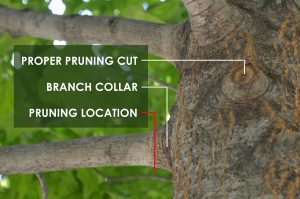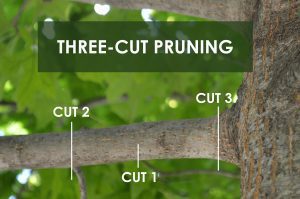Pruning Tips for Healthier Trees
Many gardeners are intimidated by tree pruning, as trees represent a significant investment in the landscape. But proper pruning is an important part of maintaining tree health. There’s no need to fret – pruning trees is not complicated. These simple pruning tips will ensure your pruning efforts provide the maximum benefit to your trees.
Safety First
Before you begin any tree trimming, it is important to assess the safety of the project. Survey the area surrounding the tree to identify potential hazards. Are there nearby power lines? Is there a dead limb hanging in the tree that can fall as you work? Call a professional if there is any question about potential safety.
The next step to consider is personal safety. Large tree limbs can weight hundreds of pounds and cause significant injury. Proper protective gear is a must when pruning trees. Wear a hard hat any time limbs or branches are removed. Eye protection keeps saw dust out of the eyes and keeps vision clear throughout the task. Hard toed boots will protect toes from falling limbs. If a chainsaw will be utilized, ear protection and chaps are recommended. Finally, if you are using a chainsaw, always work from the ground, not a ladder, and do not work directly overhead. WORX 20V Power Share Cordless Pole Saws give you the reach you need to work safely when pruning trees.
When To Prune Trees
Pruning trees at the proper time can help you avoid certain disease and health problems. The late dormant season is the best time to prune most deciduous trees. Late winter pruning minimizes the time wounds are exposed before the sealing process begins. It is also easier to make pruning decisions without leaves obscuring plant branch structure.
Of course, there are always exceptions to the rule. Some trees, including maples, walnut, and birches, have free-flowing sap that runs or “bleeds” after late winter or early spring pruning. This sap flow is not harmful to the tree but can be avoided by pruning these trees after their leaves are fully expanded in late spring or early summer. When pruning during the growing season, never remove more than 1/4 of the live foliage at one time.

Make Proper Pruning Cuts
The biggest mistake people make when pruning trees is cutting limbs too close to the trunk. Never cut flush to the trunk. Look at a growing tree branch. Notice the raised or thickened area at the base of the branch. This is the branch collar, where trees produce the cells necessary to seal wounds. A correct pruning cut removes the branch just outside of the collar.
The tree collar is not obvious in all trees. If you cannot see the collar, make pruning cuts perpendicular to the direction of the branch (rather than parallel to the trunk). This will keep the pruning wound as small as possible.

Pruning Large Limbs
Another common pruning problem occurs when a heavy branch tears the bark back along the trunk as it falls. This problem is easily avoided by using the three-cut pruning method every time you cut a heavy limb. As the term suggests, this involves removing large limbs using three pruning cuts:
- Cut 1: The first cut is made on the underside of the limb about 12-inches away from the trunk. Cut an inch or two into the limb.
- Cut 2: Make the second cut several inches further out on the limb, cutting all the way through the limb to remove the bulk of the weight.
- Cut 3: The final cut removes the remaining stub. Cut just outside the branch collar as described above.
Use these tree pruning techniques every time you prune to protect yourself and your trees. Focus your efforts on damaged, diseased, and dead limbs to keep trees looking and growing their best.
You must be logged in to post a comment.